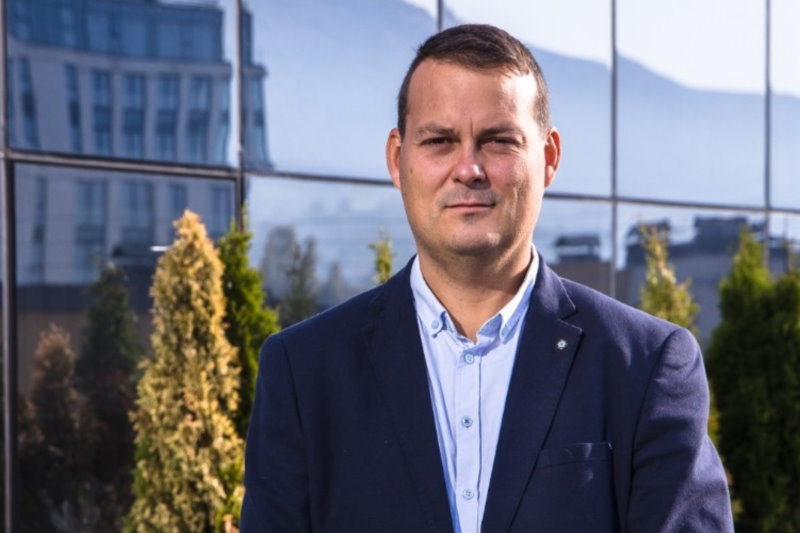
Growing together as customer and supplier through knowledge sharing
ASML has cemented its place in the semiconductor industry through a reliable integration of hardware systems and innovative designs. In recent years, software has increasingly become a crucial aspect of their operations. Software enables quicker diagnosis of hardware issues and forms the foundation of numerous optimizations in ASML’s lithography machines.
Consequently, ASML came to face new challenges, including the need for an extensive software development workforce and the management of a large-scale software infrastructure. To tackle these challenges, they sought external assistance. They engaged ICT Group and its Bulgarian subsidiary Strypes to oversee important parts of their software infrastructure.

Another difficulty faced by ASML was the onboarding process for new hires. Rob Hendriks, business unit manager high tech at ICT Group, elaborates: “About seven years ago, we struggled with the onboarding of new employees ourselves, and we set up an onboarding process to tackle this. When we observed that ASML had the same problem, we suggested our solution.” ASML embraced the proposition, and ICT Group implemented the procedure for the ASML Software Graduate Program, a 6.5-week program for fresh graduates. “We started with 12 employees quarterly, but we now manage ASML’s onboarding process for many more hires each month,” asserts Hendriks.
Two-way street
ASML conducts regular operational, tactical and strategic meetings with ICT Group/Strypes, which Hendriks greatly appreciates. “ASML discloses their industry insights, so we can prepare accordingly. This especially enables us, on a strategic level, to devise long-term plans.”
Nasko Filchev, COO at Strypes, adds that ASML’s annual Supplier Day event is very helpful. “During these gatherings, ASML discloses their challenges and needs on a tactical level to their key suppliers. The discussion expands beyond technical details to include training plans, thus equipping us for what lies ahead.” The Strypes COO also welcomes the recent assignment of a dedicated business account manager at ASML, who serves as a sparring partner in their collaboration.
Filchev emphasizes that the exchange of knowledge is a two-way street. “We actively engage ASML on specific topics of interest for them. We discuss our experiments with artificial intelligence techniques and share our advancements in this field. For instance, migrating legacy Python 2 code to Python 3 is a lot of manual labor. However, you can train a large language model to do this for you. A lot of software maintenance tasks can be automated this way.”
ICT Group/Strypes also shared their experiences in data collection for machine learning. Filchev explains that ASML’s lithography machines generate a lot of data. “You can train a model on this data to get some actionable insights. Recognizing a particular data pattern, for example, reveals that the wafer will corrupt, while another pattern indicates that the wafer table needs replacement.” ICT Group/Strypes is currently also promoting the adoption of model-based testing to ASML. “We’re convinced that it can vastly benefit their testing processes,” concludes Filchev.
Overall, Hendriks believes that sharing both ways is a key aspect of their collaboration with ASML. “By continuously learning from each other and disseminating our knowledge, we can guarantee a mutually beneficial partnership that leads to the advancement of the industry as a whole.”
Diagnostics
A key project ICT Group/Strypes has participated in, is the Twinscan Parameter Monitoring System (TPMS), a predictive maintenance system incorporated into ASML’s diagnostics. It gathers over 2,000 parameters such as laser power and temperature measurements for the Twinscan machines. “We’ve been building this for ASML for the past five years,” notes Filchev. “TPMS empowers them to predict when a machine will fail. Therefore, they don’t have to wait until a system has malfunctioned to respond, but they can take proactive measures to avoid downtime, including ordering replacements for the defective parts. This saves ASML a significant amount of downtime.”
ICT Group/Strypes also develops calibration, performance and diagnostics (CPD) software for ASML’s lithography machines, including the Python-based Viper framework for CPD tests, V-craft, and MAGE. “Many departments at ASML have their own tools. Ideally, they could be consolidated, but we support all of them,” Filchev points out.
Another notable project in which ICT Group/Strypes plays a significant role is the inline health monitoring of the deformable mirror control unit, where several performance indicators are monitored for degradation. This project is a collaborative effort between ASML, Zeiss and ICT Group/Strypes. Within this collaboration, the latter takes a large part of the project’s ownership.
Software modernization
Given the broad and complex software ecosystem, it’s no wonder that ASML still possesses a significant amount of legacy software. ICT Group/Strypes migrated ASML’s Sun Solaris platform to Linux machines and has invested a hundred man years into transitioning ASML’s software from 32 to 64 bits. Currently, the company is deeply involved in Greenhouse, ASML’s initiative to modernize its software development environment and processes.
“We’re continuously working on mitigating ASML’s technical debt by replacing legacy software with more modular alternatives,” explains Filchev. “This effort is crucial in ensuring a streamlined and efficient software environment for ASML’s operations. It also keeps the company appealing for new hires eager to work with modern software.”
In another collaboration, ICT Group/Strypes is assisting ASML in streamlining its development and release processes. Filchev explains that ASML’s software is structured as releases for distinct machine types. “When an issue is discovered in one machine, the software fix for this machine must also be replicated to other branches of the software. This includes testing, documentation, and so on. Hence, altering one line of code in a release could potentially spark numerous other changes, which is complex to manage thoroughly.”

Challenging ASML
Looking ahead, ICT Group/Strypes envisions continued growth in its partnership with ASML. After a stagnant phase in 2024, the litho giant foresees rapid expansion from 2025 onwards, and it has already requested ICT Group/Strypes for additional staff. “We’re actively working on this, as the shortage in the labor market poses a significant challenge,” reflects Hendriks. “The work is also increasing in complexity, prompting us to recruit fresh talent and further develop our existing workforce’s competencies and knowledge.”
The collaboration between ICT Group/Strypes and ASML is based on mutual expectations, emphasizes Filchev. “During the 15 years that we’ve been a supplier to ASML, we’ve grown a lot together, to the point that our mutual expectations are now pretty aligned.” He adds that ICT Group/Strypes has been growing hand in hand with ASML. “We’ve made a challenging journey together, sharing our lessons learned and our successes.”
According to Hendriks, vendors are increasingly expected to initiate ideas and challenge ASML, rather than simply conforming to requests. ASML is also starting to evaluate its relationships with suppliers across various parameters, aiming to continuously improve their collaboration. “Working with ASML is demanding yet rewarding,” Filchev concludes. “It keeps us sharp and drives our own growth.”
This article was written in close collaboration with ICT Group/Strypes.





